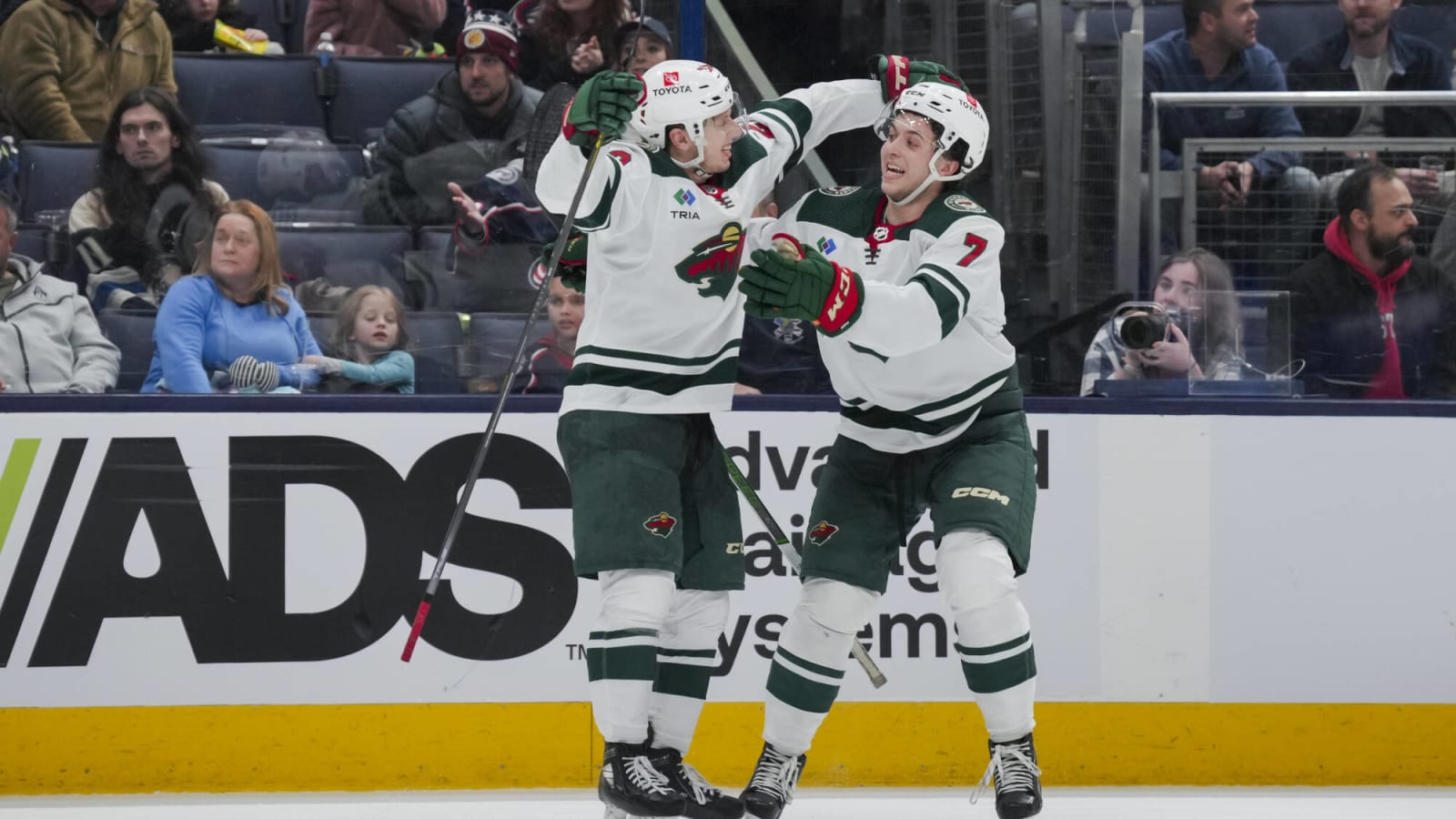
The Minnesota Wild want to extend Marco Rossi and Brock Faber, and they’d like pen to paper this offseason. “It seems certain the Wild will look to sign [Faber] to a max eight-year deal, and he’s almost certainly looking at an average annual value above $8 million per,” The Athletic reported in a recent mailbag. “Jake Sanderson signed an eight-year, $64.4 million deal with Ottawa. They’re both 21. That’s the comparable. Marco Rossi seems tailor-made for a bridge deal.”
But how is that possible with the Wild’s salary cap situation? Well, let’s do the math and find out if it’s possible.
First, how much cap would each of these extensions take up? Based on the Sanderson comp, Faber will probably command an Average Annual Value (AAV) between $8 million and $9.5 million. He’s certainly a better player than Sanderson this year, but it’s tough to project their relative value into the future. Given his RFA status, it may be tough for him to push for more money than Sanderson because of the team’s negotiating leverage.
The reporting on Rossi’s deal is less defined than on Faber’s, which makes the cap hit harder to predict. The team is reportedly pursuing eight years for Faber, but with Rossi, The Athletic only reported that it will be a “bridge deal.” A bridge deal buys up most of a player’s RFA years, giving teams a low-cost method of seeing what they have in a player. It comes with a risk of a larger payday in the future. However, it eliminates the risk of tying up too many years of salary cap on a prospect who never reaches a high-end outcome.
That makes it harder to find a comparable contract for Rossi for several reasons. First, a “bridge” could mean either a two- or three-year extension. Furthermore, Rossi is a unique prospect. At 5’9”, 182 lbs., he’s extremely undersized. He also struggled last season before showing much more promise this year.
But Rossi was incredibly productive in the minors:
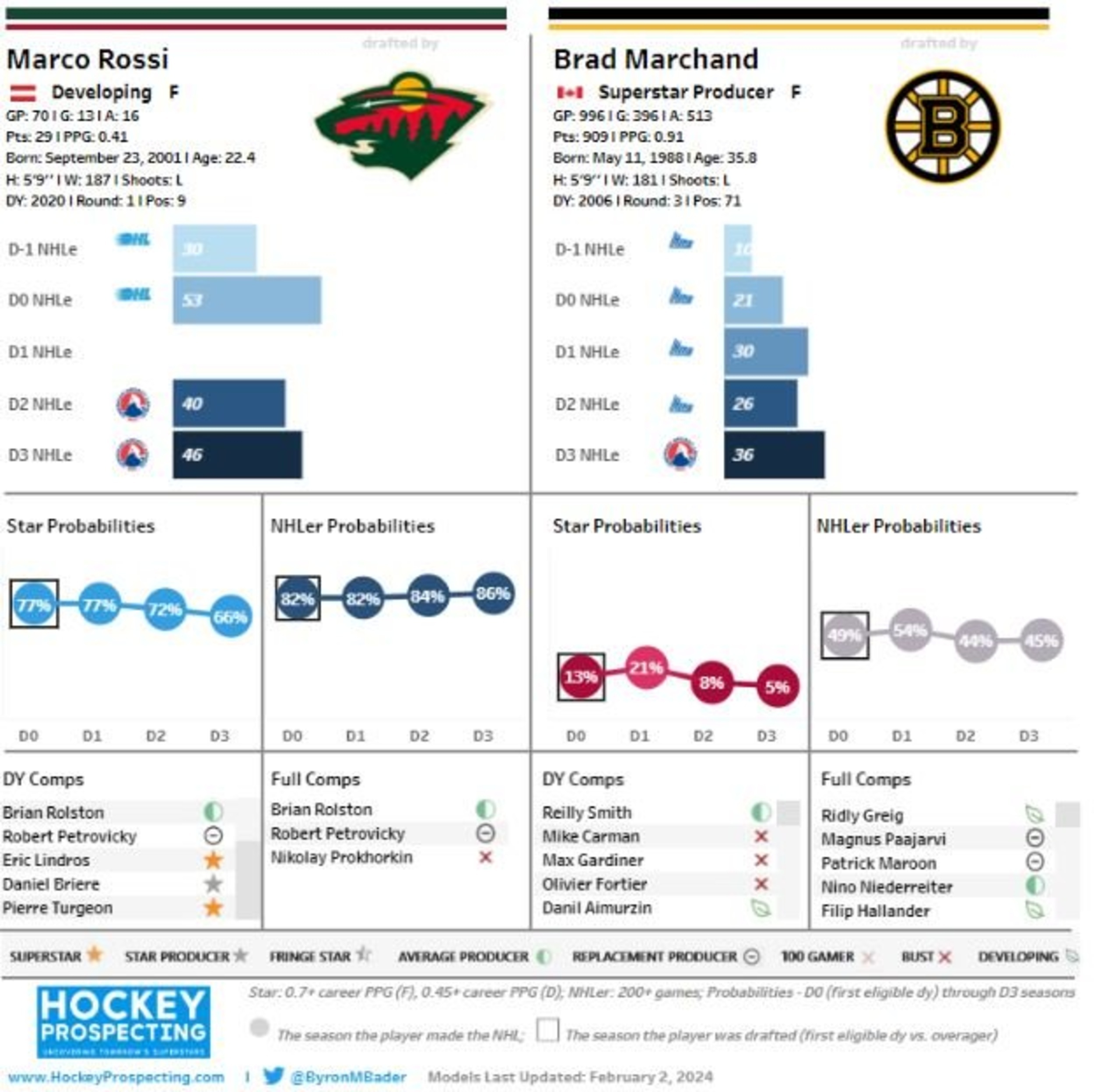
Rossi leads all rookies in goals even though 2023 projects to be one of the best draft classes of all time. He’s become one of the league’s best rookies despite missing a year due to COVID-related heart complications.
All this is to say that perhaps there’s a ceiling to what Rossi can become. Or, as his agent will surely argue, perhaps he’s on an upward trajectory to become an elite scoring center. That uncertainty could explain why Guerin wants to get a deal done this summer rather than wait to extend Rossi in the summer of 2025.
Most GMs would choose to sign a prospect later so they have more information to evaluate the player. But Guerin seems willing to gamble, as he’s done in the past with long extensions for Kirill Kaprizov and Matt Boldy. It’s a testament to his faith in his scouting and development program, but it makes it difficult to project Rossi’s market value. Still, there are a few comparable bridge deals for both a two- and a three-year extension.
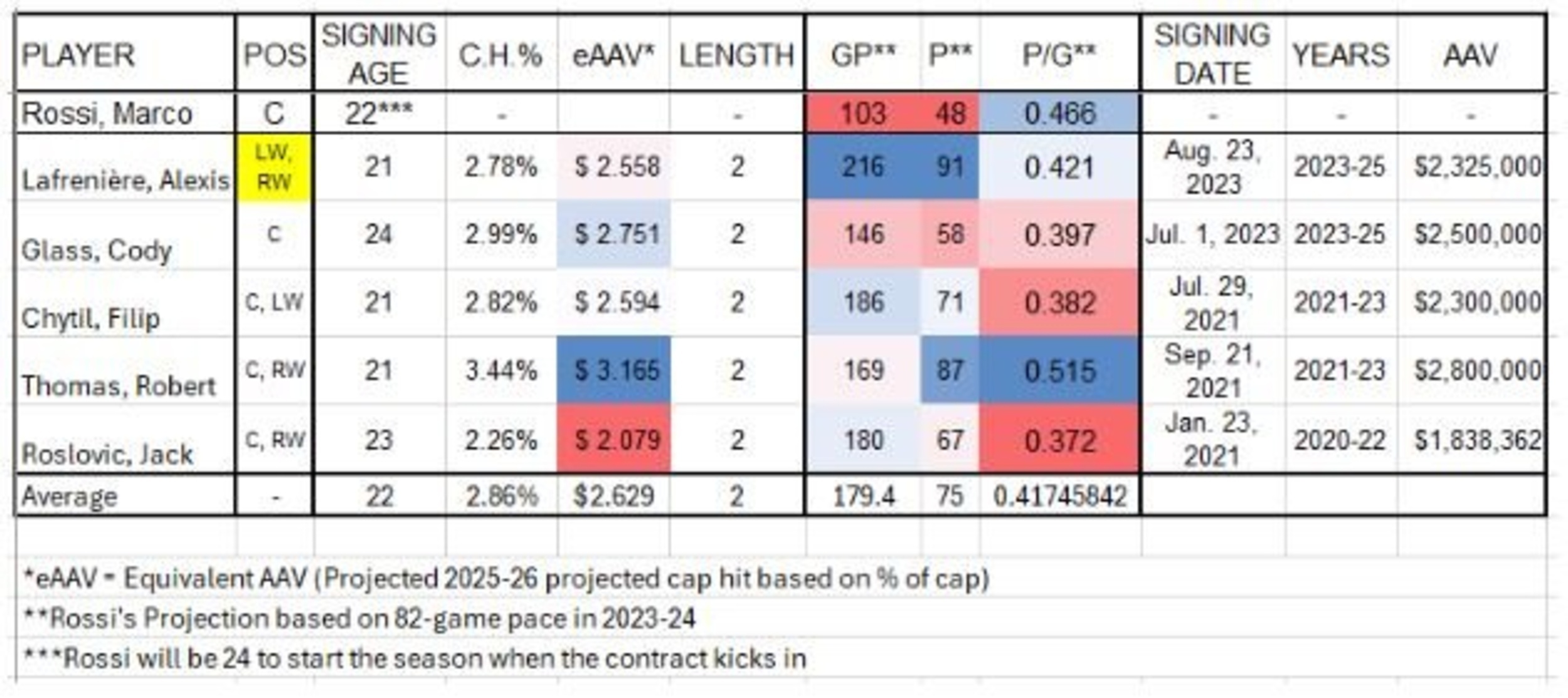
It’s easy to argue over which of these players is most similar to Rossi. Lafreniere had early struggles like Rossi before breaking out in 2023-24, but he plays a different position. Wingers usually make less than centers, so Rossi’s deal should be higher.
Cody Glass and Jack Roslovic have similar point totals and games played, and their age in the first year of their contract is similar to Rossi’s. But their points-per-game is worse than Rossi’s current pace. Filip Chytil is another analytical darling, but he doesn’t take many faceoffs, and his production also lags behind Rossi. Robert Thomas is really in a tier of his own here, serving as the upper limit on Rossi’s AAV.
So, a two-year deal for Rossi could cost anywhere between $2.5 to $3 million per year when adjusted for salary cap inflation (note the eAAV of these deals).
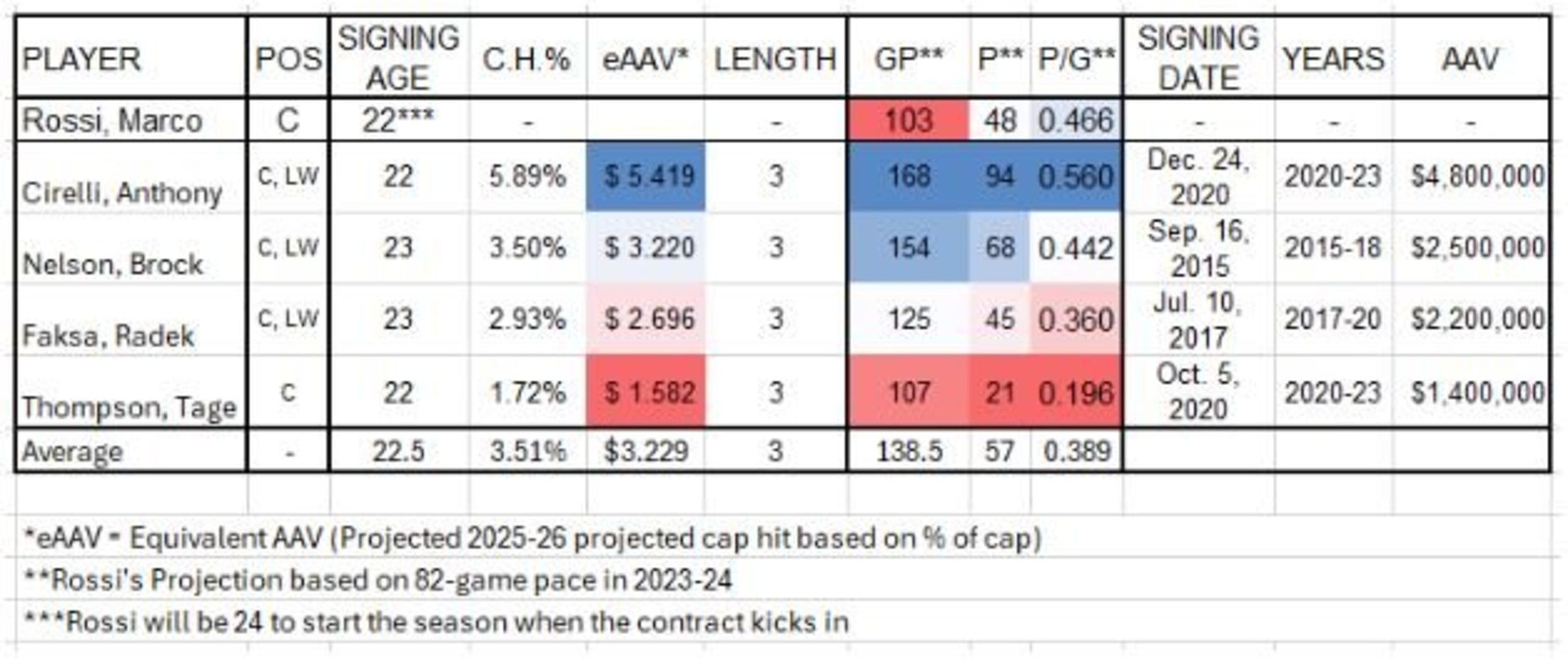
Again, it’s difficult to pick a favorite comparable here because of Rossi’s unique situation. Brock Nelson is an impeccable comparable, except he signed his deal nearly a decade ago. Radek Faksa and Tage Thompson didn’t have Rossi’s scoring production. Anthony Cirelli had great advanced stats, but his scoring is so superior to Rossi’s that he probably only represents the ceiling of Rossi’s three-year AAV.
Therefore, Rossi’s three-year AAV could be anywhere between $2.5 and $4.5 million.
A three-year deal would probably be more expensive, but it could save the Wild money in the future. If Rossi signs a two-year deal, there’s a chance that his 2027-28 cap hit will be much more than $3 to $4 million.
Guerin will come to the table with Rossi’s agent, and they’ll probably discuss the prospect of both deals. Both will likely seek a three-year deal, as players typically prefer long-term security, and Guerin has a history of long extensions to young players. On the other hand, the third year is the most valuable and should increase the AAV of the contract.
Ultimately, the team could afford to extend Rossi for three years at $4 million if they needed to, but only if that deal reduces his 2027-28 cap hit. That would be the determining factor in the length of Rossi’s extension.
Managing the salary cap is complicated. It’s easy enough to focus on each deal, bring in as many positive value contracts as possible, and suddenly run into cap hell. To ensure that today’s great deals don’t become tomorrow’s problems, GMs must look at team needs and salary cap costs over each of the next several seasons.
I have great news, Wild fans: next year’s cap hell has been greatly exaggerated.
In 2024-25, Minnesota's to-do list includes extensions or replacements for:
- Adam Beckman (RFA, $894,167)
- Connor Dewar (RFA - arbitration, $800,000)
- Brandon Duhaime (UFA,$1,100,000)
- Alex Goligoski (RFA, $2,000,000)
- Declan Chisholm (RFA, $775,000)
- Marc-Andre Fleury (UFA, $3,500,000)
- Patrick Maroon (UFA, $800,000)
The Wild can use their prospect pool to replace some of these players. For example, if Beckman replaces Duhaime, a less expensive option can backfill his spot in Iowa. If Marat Khusnutdinov joins the third line, he can bump Frederick Gaudreau to the 4C spot and replace Conor Dewar indirectly. The Wild have penciled Jesper Wallstedt in as a backup, and backfilling his role in Iowa is cheaper than bringing in a free-agent backup goaltender. Chisholm’s qualifying offer should only cost $814,000, and he should be a suitable (albeit young) third-pairing defenseman rather than shelling out for a free agent.
Danila Yurov is the most important piece. He’s the best bet to fill a third-line role, but they’ll need to bring in a free-agent third-line winger to replace Patrick Maroon if he stays a year in Russia. Per Dom Luszczyszyn’s analytical model, a third-line forward was worth $2.7 million last offseason. Adjusted for salary cap inflation, that comes to $2.83 million -- nearly $2 million more than Yurov would cost.
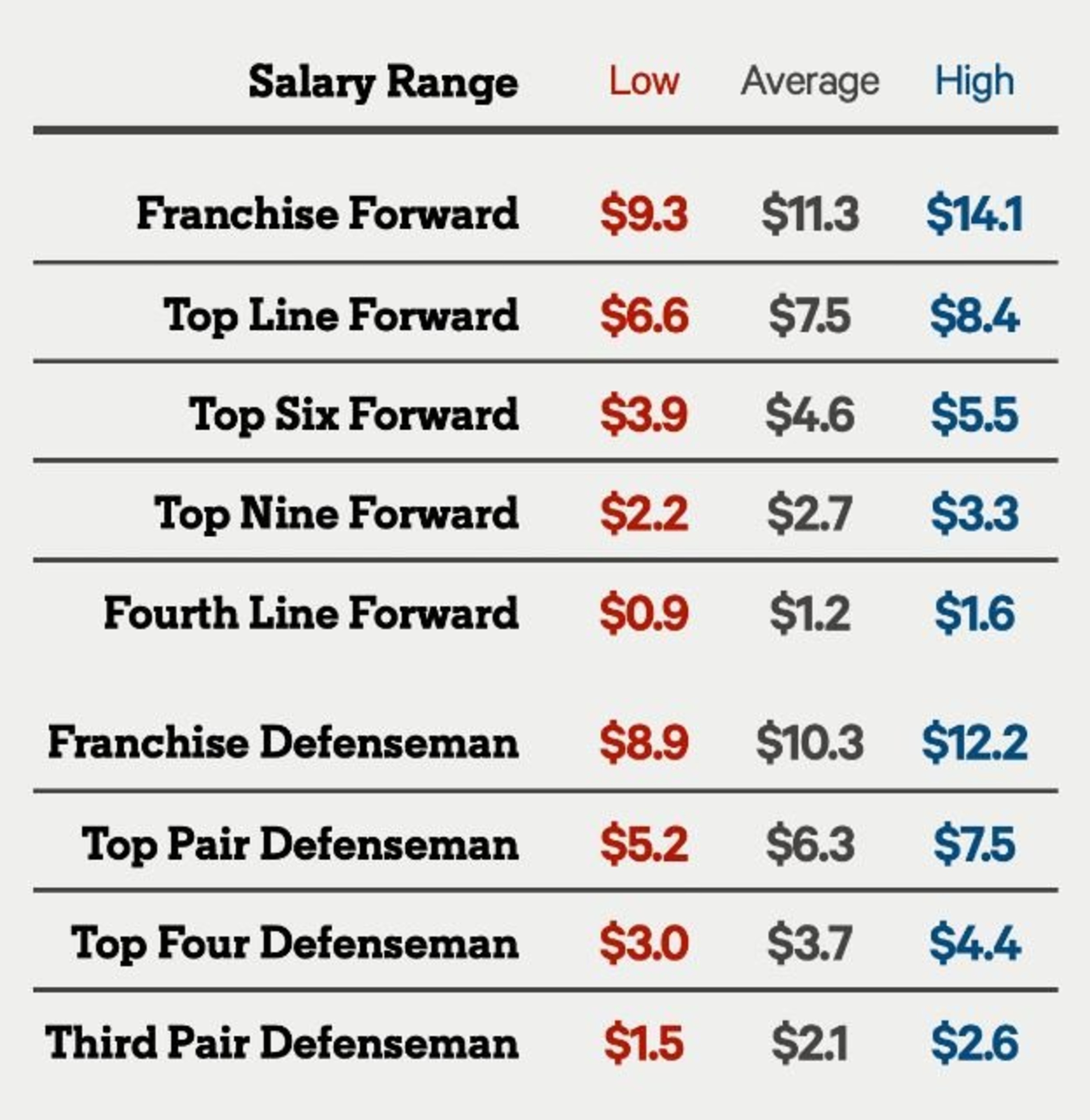
If Minnesota checks off everything on their to-do list and brings in a free-agent defenseman at market rate, they still have $3 million in cap space to play with. If Yurov and Khusnutdinov can play third-line minutes, they’d have $4.9 million. The only drawback of this plan is putting Beckman into a fourth-line role, which could be mitigated by spending some of that space on a short-term fourth-line forward in free agency. All of that still leaves enough room to add a player at the deadline if Minnesota wants to.
Alternatively, Minnesota could bolster its defense corps with the remaining cap space. They’d have $2.6 million to work with if they leave Beckman in Iowa, pay a fourth-liner $1.25 million, and Yurov stays in Russia. They could use that to go big-game hunting when they replace Maroon or Goligoski. That’s the difference between a third- and a second-line value.
All this means that next year’s team could be younger, deeper, and better -- even with dismal injury luck. So what does it look like once Faber and Rossi get a raise in 2025-26?
Rossi and Faber’s extensions would start in ‘25-26, and there will be another offseason to-do list:
- Jesper Wallstedt (RFA, $925,000)
- Jake Middleton (UFA, $2,450,000)
- Chisholm (RFA - arbitration, $813,750)
- Beckman (RFA - arbitration, $874,125))
- Marcus Johansson (UFA, $2,000,000)
This year is really going to test the youth. The Wild will have to pay a market-rate free agent for every Daemon Hunt, Carson Lambos, Chisholm, and Ryan O’Rourke that can’t replace Middleton, Goligoski, Merrill, and Zach Bogosian. That means that mostly rookies will fill the bottom four defense spots. Minnesota won’t be able to easily shelter these players behind Spurgeon and Brodin because they’ll be 36 and 32 years old, respectively.
The youth will also be tested up front. Yurov, Khusnutdinov, Beckman, and Liam Ohgren may all be able to play in the top nine forward slots, but that’s not a sure thing. They’ll need those players to replace Johansson, Dewar, and Duhaime. Beckman has struggled to stick with the big club, and Ohgren has endured some concerning injuries that may slow his development. Khusnutdinov is undersized, and Yurov may stay in the KHL for a more secure salary. If he doesn’t come over until age 23 (the same age Kaprizov came to North America), he wouldn’t be available in ‘25-26.
Assuming the Wild address all these points of failure, they have plenty of room for Faber and Rossi extensions. $2.5 and $9 million extensions, respectively, leave $12.8 million of cap space. If the team pays up in 2024-25 for their Goligoski or Maroon replacements, that could be as low as $7.9 million. But even that should be enough to add a top-six forward or a second-pair defenseman in free agency, which eases the pressure on Minnesota’s youth.
That’s a bit tight, but that leaves room for a three-year deal for Rossi and a $9 million AAV to Brock Faber. Minnesota should wait to see Chisholm and their rookies in training camp this offseason before extending Rossi for a third year. But all bets are off if four or six of Minnesota’s young players appear on track to play in ‘25-26. But if those players look like they’ll need more than a year of development in Iowa, Guerin should focus on extending Rossi to a two-year prove-it deal.
Minnesota’s situation is far from gloomy. For all the issues with extensions to Marcus Foligno, Ryan Hartman, and Mats Zuccarello, it seems that the team is primed to compete in both of the next two years -- especially after the Parise and Suter cap hits drop from $14.7 million to $1.7 million. As long as Guerin can control his urge to extend aging veterans, the Wild should be competitive in ‘25-26.
Coincidentally, that’s Kaprizov’s contract year. If the team locks in Rossi and Faber and competes in the playoffs that year, it would be a compelling pitch for Minnesota to be Kaprizov’s first UFA destination.
All statistics courtesy of CapFriendly.com
More must-reads:
- NHL announces Ted Lindsay Award finalists
- Rangers special teams, goaltending help them take control against Hurricanes
- The 'Yearly NBA playoff leaders in PPG' quiz
Breaking News
Customize Your Newsletter
 +
+
Get the latest news and rumors, customized to your favorite sports and teams. Emailed daily. Always free!

